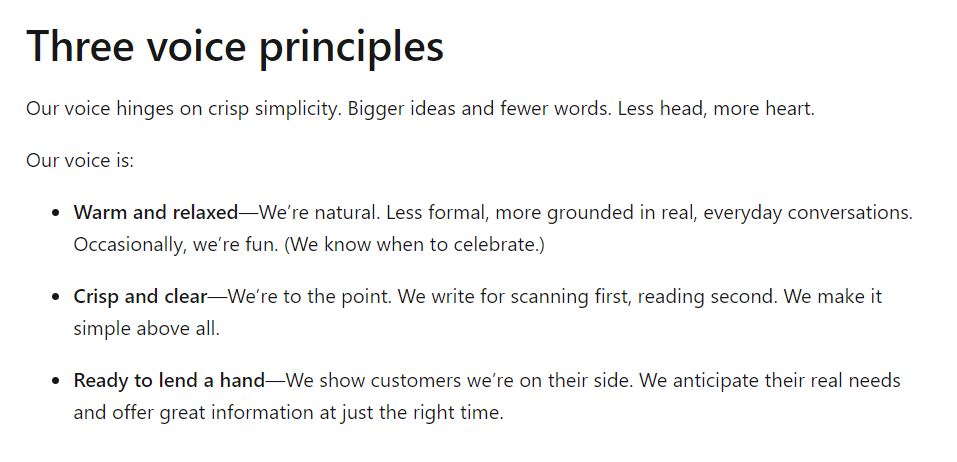
Let’s say you meet someone new at a party. They speak formally and professionally in a voice that’s calm and soothing.
You bump into them the next day on the street and they are using slang, and cursing at the top of their lungs.
You’d be confused and put off by the difference.
That’s exactly what customers feel like when they read something on your website that sounds one way, only to find you sound different on your social media.
Of course, you probably won’t have a difference as drastic as the example above, but even tiny differences can be off-putting to consumers.
Why you need a style guide
The best way to avoid that problem is to create a style guide for your business. This is a must if you have more than one person writing for you.
You really can’t create an effective brand without it.
By creating a solid style guide, you can build rapport with your customer and strengthen your brand position. Without it, your message can sound strange.
And that equals a customer looking for the exits.
So, save yourself an exercise in frustration and lost revenue. Take a few minutes to learn how to build a style guide that will pay big dividends for your business.
How to build your guide
You’re going to need to know a couple of simple things before you start building out your brand’s style guide.
First, determine what your customers want to hear.
When Alex Lieberman and Austin Rief started the business newsletter Morning Brew, they wanted to reach a younger generation of readers frustrated by mainstream media’s buttoned-down approach to journalism.
So, they put a voice to business news that was engaging and entertaining, but still informative.

Next, know what you want your customers to say about you.
Morning Brew’s editorial team would love to overhear a conversation about how informative and entertaining they are.
But they’d cringe if they heard someone from their target audience say they were silly and couldn’t be taken seriously.
Getting to the bottom of what your customers want to hear and what you want them to say about you might take some time. And the answers may reveal holes in your mission statement, vision statement, and branding strategy.
That’s okay.
A style guide is another layer of your brand. Now is the time to backtrack and solidify who you are and where you want to be in the marketplace.
Next, it’s time to decide what you want in your guide.
Goals and Principles

Ask yourself this question: What do I want my content to accomplish for my customer?
For example, when I produce content, I want to:
– provide unique insight
– speak with some degree of depth to empower readers
– speak clearly and honestly so readers will have a firm grasp of the message and feel it has value for their business.
– Give practical marketing advice that can be easily implemented.
Those are my goals. My principles to reach them are:
– Be a teacher. Know who you are talking to and how much they already know.
– Be a researcher. Dig deep into reviews, listen to people in business to know their wants and needs.
– Use constructive criticism. If everything isn’t okay (and it never is) then address it with a solution.
What are your guiding roles and principles? What do you want your company to be to your customer?
Jot those down.
These must be available for your writers, so they understand what you are trying to achieve.
Define Your Voice and Tone
When I was a teacher, I learned all about the importance of tone and voice.
In the classroom, I spoke in a professional manner that was easy to understand. No slang, no profanity, and no fancy words. That was my voice. The students came to expect it, and when it changed (as it sometimes did), you could see it in their faces.
Utter the latest street slang? They’d call me on it. Fake!
Now, how I said things changed often. I usually tried to keep a confident tone, but I could change it based on the situation.
Each tone was designed to meet the audience where they were and get them to take the action I wanted. I needed those 30 kids in my class to feel calm amid the swirl and whirl of middle school life.
So, it is with your style guide. Your voice should never change. If you adopt a professional voice, keep it consistent across all your mediums.
But your tone can change. Sometimes it may be relaxed and comforting; other times, it may be more exciting and urgent.
So, when you adopt your tone of voice, think about what your audience can accept and what you need to accomplish. Then, coordinate that with your goals and principles.
Creating your Voice
Choose guiding words that will help writers understand the persona you portray. For example, Microsoft uses the description below.

So, as a copywriter, I know right away what foundation to work from and how I should approach each piece of copy.
Define Style, Grammar, and Mechanics
Define essential elements of style. Be sure your writers understand where you stand on:
– abbreviations and acronyms
– active voice and passive voice
– capitalization
– slang
– acronyms
– contractions, numbers, dates, time, temperature, and telephone numbers.
There may be other things that you’ll want to standardize across the board. Take some time on this because it can have a big impact on your voice.
For example, if you want to sound friendly and informal, you should encourage contractions. They make you sound more like the buddy giving advice than a college professor lecturing to a class.
Discuss how to write across mediums
Be sure to discuss how you want to present yourself across mediums like your website, social media platforms, and blogs and articles.
Talk about how concise these should be on average.
Also, determine what you want your tone to be in each of these areas. Social media can be a little tricky if your audience is diverse. Your Facebook audience may be completely different from your TikTok audience, so keep that in mind when writing guidelines for each.
Wordlist
There might be words you don’t want used in your copy. It may be to preserve voice or just to differentiate yourself. Check out the words on MailChimp’s bad boy list.

This slew of words is banned because they either don’t fit into the company’s voice, go against their principles, or are considered cliché’.
You’ll want to do this, as well. This will probably be one of the most fluid parts of the style guide. Be prepared to change it as you read copy from your writers and begin to notice words that don’t fit into your voice.
Next Steps

Okay, so you made a style guide. Now what?
Decide how you are going to distribute it. Many companies make it part of their brand standards. Others keep it as a separate document.
That really boils down to who is going to be using it. Whatever you do, make it an attachment in every assignment you give .
Just doing that sends the message the content guide is important. And don’t worry about sounding naggy. It’s your brand, and you need to protect it.
I’d rather have someone ask me ten times, “Did you follow the content guide?” than tell me one time, “Try again. I’ll know what I want when I see it.”
As a writer, if a business owner is insistent about the style guide, that’s a good thing. It tells me she doesn’t see words as a commodity and gets the importance of how they impact her brand and bottom line.
But if they hit me with the “Try again” line, it tells me they don’t know what they are doing, and I am flying blind.
Which sucks, by the way.
A couple of examples
Style guides are unique to each company, so it is best to have examine a few examples to see how you want to structure yours.
Here are a few to get you started.
Mailchimp keeps its style guide separate from its brand standards. It’s a good one to check out if you have a very diverse audience.
The star chef weaves the content style guide into his brand standards for a comprehensive look. Check it out if your brand is graphic intensive or has different product lines.
The retail giant places its content style guide within its brand standards. It’s a great example of a refined guide by a company that has seen it all and adapted to it.
One more thing
Once your style guide starts getting used, figure out where it can be improved and make the changers as quickly as possible.
A content guide is a living document, so don’t worry about getting it perfect the first time.
That’s it! You’re one step closer to solidifying your brand, eliminating confusion, and being more profitable.
Oh, and you’re one step closer to being the kind of client or boss every writer wants. So, on behalf of all the copywriters out there, thanks!

